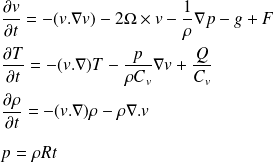Scaling analysis : anisotropy
The same scaling analysis can be conducted in the case of anisotropy. We will see that the effect of the gravity and Coriolis forces add some complexity to the analysis. The governing equations :

 Is the earth rotation,
Is the earth rotation,
 is the gravity,
is the gravity,
 represents the source and the sink of energy,
represents the source and the sink of energy,
 is the universal gas constant
is the universal gas constant
 is the specific heat constant.
is the specific heat constant.
The detail of the scaling analysis in the case of anisotropy can be found in [Lovejoy and Schertzer, 2014][1], where :






